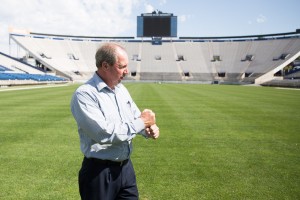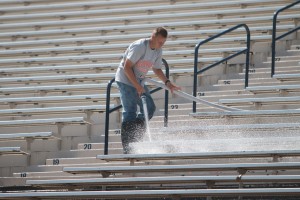
The LaVell Edwards Stadium is the classic friend who takes a year to get ready. Literally.
Grounds Stadium Manager Jon Quist and his crew of seven student employees work nearly year round to prepare the stadium and field for the next season.
“We’re always working on the field to get it ready for the football season,” Quist said. “The whole year is a process.”
The stadium is seen by the public for a few occasions: football games, Stadium of Fire and special events such as the Payson Utah Temple Cultural Celebration. Several weeks out of the year, football camps utilize the field, but for most of the year, LaVell Edwards Stadium is closed. No one is allowed in, and an infrared security system is sure to alert BYU Police any time there is an intrusion.
Despite the small number of days the stadium is in use, Quist said that in the off-season, 40 percent of his time is spent at the stadium working on either the field, the seats or landscaping around the stadium. The other 60 percent is spent at the BYU football practice field, which is used daily. During football season, he said, the split is more 50/50.
Ultimately, a college football stadium is not vastly important, yet incredible care is taken to protect the grass. For example, during Stadium of Fire there was a moment where Mentos and Diet Coke were exploded all over the field just before the band appeared on stage. What many may have missed, however, was the cleanup crew that washed all the soda off the field as soon as the experiment was over and the crowd was distracted by the band.

Even three weeks after Stadium of Fire, Quist’s team was still using a 150-foot firehose to wash firework residue from stadium seats.
“You kind of appreciate the game a little bit more because you realize there’s actually stuff that had to go into making it happen,” said Ben Hales, a BYU sophomore from Santaquin, who has worked with Quist for two years. There’s more to a football game than the players running out onto the field and playing, Hales said.
Glenl Wear, BYU Grounds Director, said that after the last football game of the season, usually in November, Quist and his team begin prepping for spring. Tarps are laid down to protect the field. Three months later, the tarps are removed, and, Quist said, they begin to “wake up” the field for spring ball.
Preparing the grass for football mostly consists of typical gardening measures: aerating, watering, mowing, fertilizing, reviving and replacing dead patches. But there is one step most gardeners are unfamiliar with. Three days before the first game, Quist and his team paint the field.
“I’ve always enjoyed painting,” Quist said. “I have to admit, there are times when I’m a little selfish with this part of the job. I just enjoy it.”
From February through November, Quist and his crew paint the practice field multiple times a week, but soon they’ll paint the field at LaVell Edwards Stadium.
When they paint the field, Quist said, he and his team will take 2.5 days to measure, rope off and paint. Each time they paint the field, they use about 65 gallons of paint. The field gets remeasured and repainted for every game. “We repaint between each game no matter what,” Quist said.
Game days are typically at least 18-hour days for Quist. During the game he is not just a spectator. He and his team pull the nets up at the field goals, and often one can find Quist walking on the field during timeouts to fix a piece of grass that has been pulled up.
When the game is over, Quist said he usually stays about five hours after, replacing torn-up pieces of the field. Wear said various BYU clubs spend three to six hours cleaning the stadium after games.
The grass that is now in the stadium has only been there since 2009. Wear said the grass has improved ever since. Many factors are considered when debating how long the grass will go between replacements, but Wear said the goal is to manage the grass for at least 15 years.
As for grass versus artificial turf? For Quist, it’s no comparison: grass is better. Grass is cooler, and for players who are repeatedly hit, it’s a better surface to fall on.
The BYU football team will play Boise State on Quist’s freshly painted field in the first home game of the season on Sept. 12 at 7:30 p.m.




